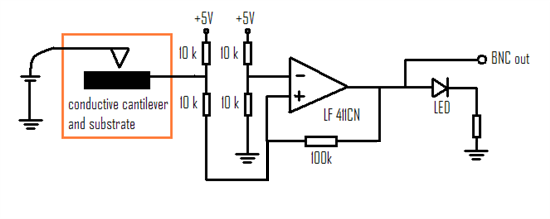Hello,
I am trying to build a simple circuit that can detect whether a conductive nanoscale cantilever probe (basically, a sharp needle) is touching a bare Au substrate. Currently, I have used one of TI's op-amp evaluation boards (Area 100, page 2-3 here: http://www.ti.com/lit/ug/slou062a/slou062a.pdf), and built a non-inverting amplifier using a LF411CN.
The circuit diagram is shown here:
Do you have any suggestions as to how I can improve the noise/ improve the design of this simple current sensing circuit without having to get too complicated? Sometimes when the non-inverting (+) input has been grounded but the inverting (–) input is still floating, the output suddenly oscillates like crazy; this happens unpredictably. The ground is provided by the atomic force microscope (AFM) that the cantilever probe is a part of.
Thank you!!
Aaron



